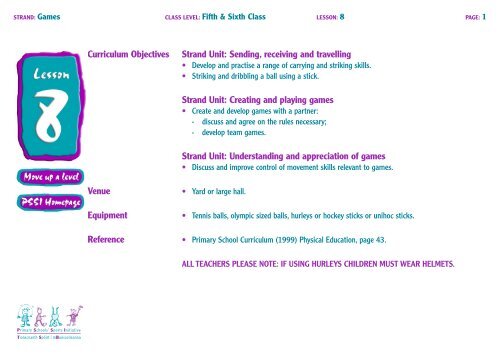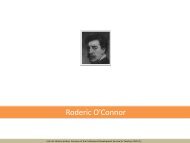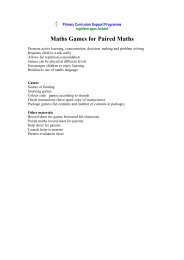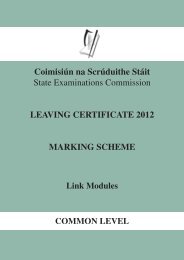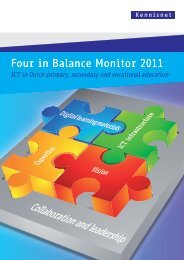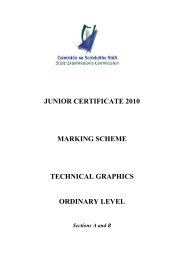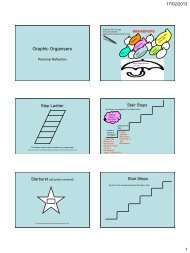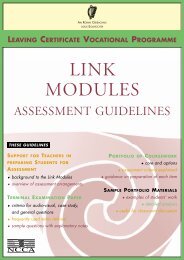Curriculum Objectives Strand Unit: Sending, receiving and ... - PPDS
Curriculum Objectives Strand Unit: Sending, receiving and ... - PPDS
Curriculum Objectives Strand Unit: Sending, receiving and ... - PPDS
You also want an ePaper? Increase the reach of your titles
YUMPU automatically turns print PDFs into web optimized ePapers that Google loves.
STRAND: Games CLASS LEVEL: Fifth & Sixth Class LESSON: 8 PAGE: 1<br />
<strong>Curriculum</strong> <strong>Objectives</strong><br />
<strong>Str<strong>and</strong></strong> <strong>Unit</strong>: <strong>Sending</strong>, <strong>receiving</strong> <strong>and</strong> travelling<br />
• Develop <strong>and</strong> practise a range of carrying <strong>and</strong> striking skills.<br />
• Striking <strong>and</strong> dribbling a ball using a stick.<br />
<strong>Str<strong>and</strong></strong> <strong>Unit</strong>: Creating <strong>and</strong> playing games<br />
• Create <strong>and</strong> develop games with a partner:<br />
· discuss <strong>and</strong> agree on the rules necessary;<br />
· develop team games.<br />
<strong>Str<strong>and</strong></strong> <strong>Unit</strong>: Underst<strong>and</strong>ing <strong>and</strong> appreciation of games<br />
• Discuss <strong>and</strong> improve control of movement skills relevant to games.<br />
Venue<br />
Equipment<br />
• Yard or large hall.<br />
• Tennis balls, olympic sized balls, hurleys or hockey sticks or unihoc sticks.<br />
Reference • Primary School <strong>Curriculum</strong> (1999) Physical Education, page 43.<br />
ALL TEACHERS PLEASE NOTE: IF USING HURLEYS CHILDREN MUST WEAR HELMETS.<br />
Primary Schools’ Sports Initiative<br />
Tionscnamh Spóirt i mBunscoileanna
STRAND: Games CLASS LEVEL: Fifth & Sixth Class LESSON: 8 PAGE: 2<br />
ORGANISATION<br />
Divide the children into groups of six.<br />
Each child has a hockey stick or hurley.<br />
Consider grouping children of similar<br />
ability.<br />
Mark out grids ten metres square – one<br />
group to each grid with three balls.<br />
Change the activities after four or five<br />
minutes.<br />
Place a set of three cones in each grid for<br />
Activity 1.<br />
ACTIVITY<br />
Warm up <strong>and</strong> stretching: Visit your warm up bank.<br />
The teacher can decide to revise skills in Sections 1, 2 <strong>and</strong> 3 in a grid setting or go straight to playing the<br />
game in Section 7.<br />
1 Slalom dribbling<br />
(a)<br />
(b)<br />
(c)<br />
(d)<br />
In three groups of two, each<br />
child in turn dribbles the ball<br />
between the cones <strong>and</strong> back.<br />
After three or four practice<br />
runs ask the pairs to compete<br />
against one another.<br />
Winner: the best of three<br />
races.<br />
Beat the clock: How many<br />
runs can a pair complete in two minutes<br />
If using hurleys, the children can solo. Balance the ball on the hurley while running to the last<br />
cone <strong>and</strong> back. Run up one side of the cones <strong>and</strong> down the other.<br />
The children can then be challenged to perform this activity by running in <strong>and</strong> out of the cones.<br />
The first player in each line dribbles the ball to the last cone, strikes it back to the next team<br />
mate <strong>and</strong> sits down. The first team to have transferred across are the winners.<br />
TEACHING POINTS<br />
• Bend the knees.<br />
• Grip:<br />
· If using a hockey/uni-hoc<br />
stick, the strong h<strong>and</strong> is the<br />
lower h<strong>and</strong>;<br />
· If using a hurley, the strong<br />
h<strong>and</strong> is at the top of the stick.<br />
• Emphasise control of the ball.<br />
• Encourage the children to develop<br />
rules which will favour good control<br />
e.g. loss of control of the ball<br />
means you must go back to the<br />
nearest cone before continuing.<br />
Remove the middle set of cones <strong>and</strong> ask<br />
the children to break into two groups of<br />
three <strong>and</strong> to face each other, two opposite<br />
one – one ball per group.<br />
C<br />
B<br />
C<br />
B<br />
2 Pressure Passing<br />
A passes the ball to B who blocks it <strong>and</strong> passes it back to A who then passes it to C.<br />
Alternate the front person after two or three minutes.<br />
• Emphasise control, e.g. stop the<br />
ball, then hit the ball back to<br />
your partner. Briefly discuss with the<br />
children why this is necessary.<br />
• Emphasise the speed of movement:<br />
stop <strong>and</strong> hit immediately.<br />
A<br />
A
STRAND: Games CLASS LEVEL: Fifth & Sixth Class LESSON: 8 PAGE: 3<br />
ORGANISATION<br />
ACTIVITY<br />
TEACHING POINTS<br />
3 Games: 3 v 3 – A <strong>and</strong> B<br />
Team A is given possession of the ball <strong>and</strong> tries to make four or five passes without interception by<br />
Team B. If successful they earn one point. Now Team B have possession <strong>and</strong> try to do the same.<br />
Rules:<br />
• Play must remain within the grid.<br />
• If the ball goes outside the grid or if the ball is intercepted possession is given to the other<br />
team.<br />
• No pushing, pulling or dragging.<br />
The children return to pairs <strong>and</strong> line up<br />
as below.<br />
If using hurleys, other skills which could be included are the following:<br />
4 Striking from the h<strong>and</strong> using a hurley (Advanced skill)<br />
The children practise striking the ball from the h<strong>and</strong>.<br />
The following are instructions for right-h<strong>and</strong>ed players:<br />
• Hold the ball in the left h<strong>and</strong>.<br />
• Hold the hurley upright in front of the right shoulder with the bas (top of hurley) above head<br />
height.<br />
• Throw the ball up to shoulder height.<br />
• Swing through with the hurley hitting the ball at a height between the knee <strong>and</strong> hip.<br />
Practise without a ball then with a ball.<br />
• If a child continues to miss, shorten<br />
the grip on the hurley gradually<br />
moving back to the full length grip<br />
as the skill level improves.<br />
• Don’t throw the ball too high.
STRAND: Games CLASS LEVEL: Fifth & Sixth Class LESSON: 8 PAGE: 4<br />
ORGANISATION<br />
ACTIVITY<br />
TEACHING POINTS<br />
The pairs st<strong>and</strong> two metres apart as<br />
below.<br />
5 Passing from the h<strong>and</strong><br />
(a)<br />
(b)<br />
Holding the hurley in the<br />
dominant h<strong>and</strong> the child has<br />
the ball in the non-dominant<br />
h<strong>and</strong>. Throw the ball a short<br />
distance in the air <strong>and</strong> h<strong>and</strong><br />
pass with the palm of the h<strong>and</strong><br />
to partner.<br />
A balances the ball on the<br />
hurley for 10 seconds. On the<br />
whistle toss the ball into the<br />
air <strong>and</strong> palm it to the partner<br />
who catches it <strong>and</strong> repeats the<br />
exercise.<br />
• Do not throw the ball too high<br />
• Keep the striking h<strong>and</strong> close to the<br />
ball.<br />
6 Blocking <strong>and</strong> striking (advanced skill)<br />
Blocking a high ball<br />
Stage 1<br />
Practise the sequence outlined across with<br />
an imaginery ball.<br />
Stage 2<br />
Partner 1 throws the ball above head<br />
height to Partner 2.<br />
Partner 2 blocks the ball<br />
in the air <strong>and</strong> strikes it back.<br />
After five turns switch roles.<br />
• Extend the hurley overhead.<br />
• Slide the weaker h<strong>and</strong> down the<br />
h<strong>and</strong>le of the hurley to meet the<br />
stronger h<strong>and</strong> at the top of the<br />
h<strong>and</strong>le.<br />
• Keep the eyes on the ball at all<br />
times.<br />
• Relax the grip to deaden the ball on<br />
impact.<br />
• Allow it to fall to the ground.
STRAND: Games CLASS LEVEL: Fifth & Sixth Class LESSON: 8 PAGE: 5<br />
ORGANISATION<br />
Mark out two pitches.<br />
Divide the children into four teams.<br />
Each team fields seven children at a time.<br />
Rotate the substitutes regularly.<br />
The teacher should be in a position<br />
to have a view of all the children.<br />
If playing indoors use uni-hoc sticks or<br />
indoor hurleys <strong>and</strong> implement the<br />
rotation of teams suggested in Lesson 2.<br />
ACTIVITY<br />
Games should be ground striking only but if you have skilful players, one pitch could be<br />
organised to allow striking from the h<strong>and</strong> <strong>and</strong> h<strong>and</strong> passing.<br />
7 Games: 6 v 6 striking games<br />
If you have decided to devote the lesson to playing the game, watch out for opportunities to<br />
make important teaching points, e.g. accurate passing, movement into space, good technique.<br />
To start the game:<br />
• The ball is passed off/thrown in from the centre of the field.<br />
• Each player may remain in his/her own half of the field or take up attacking <strong>and</strong> defensive<br />
positions at the beginning of play.<br />
Playing the Game<br />
• The emphasis is on interception, blocking <strong>and</strong> moving into space for a pass.<br />
Rules:<br />
• The teams play with no goalkeeper but with two goals to defend <strong>and</strong> two goals to attack.<br />
• No player may st<strong>and</strong> within three metres of the goals.<br />
• Play begins as above.<br />
• Depending on space available this can be played as described above.<br />
ALL TEACHERS PLEASE NOTE: IF USING HURLEYS CHILDREN MUST WEAR HELMETS.<br />
IF USING HOCKEY STICKS, ONLY USE THE BALL DESCRIBED ABOVE IN THE EQUIPMENT<br />
SECTION. DO NOT USE A STANDARD HOCKEY BALL.<br />
8 Games: four goal game<br />
Rules:<br />
• The teams play with no goalkeeper but with two goals to defend <strong>and</strong> two goals to attack.<br />
• No player may st<strong>and</strong> within three metres of goals.<br />
• Play begins as above.<br />
• Depending on the space available this can be played as described above.<br />
9 Cool down<br />
Visit your cool down bank.<br />
DEVELOPMENT<br />
Repeat the game only, looking for greater underst<strong>and</strong>ing of tactics <strong>and</strong> an awareness of positions,<br />
e.g., forwards <strong>and</strong> backs.<br />
TEACHING POINTS<br />
Discuss:<br />
Q How will we start the games,<br />
restart after a goal<br />
Q Will tackling be allowed<br />
Q What happens if the ball goes out<br />
at the end line<br />
Q What does mark a player<br />
mean<br />
Q How can we avoid bunching<br />
together<br />
Q What should the penalty be for<br />
anyone who pushes or drags an<br />
opponent<br />
• Encourage the children to:<br />
· move into space to receive a<br />
pass;<br />
· mark a player.<br />
• Penalise the team if a player<br />
attempts to act as a goalie.<br />
• Encourage short accurate passing.<br />
• Encourage give <strong>and</strong> go.


